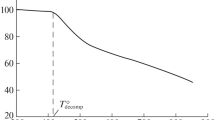Summary
Calorimetric measurements by DSC technique have been made in pure polyethylene glycol (PEG) and oxide (PEO) polymers having a very wide molecular-weight range (from 600 to 4000 000) and in PEO (MW 600 000)-NaSCN complexes. It was found that the melting temperature increases with increasing molecular weight, ranging from 293 K in the polymer with MW=600 to 340 K in that with MW=4000 000. The behaviour of the heats of fusion with increasing molecular weight reflects the trend expected in systems, in which the increase of the main chain length produces a relevant growth of the degree of crystallinity. A distinct maximum of the heat of fusion has been found at about MW=10000, this result being an evidence of the high amount of crystalline regions building up the structure of that system. The dependence of the melting temperature on molecular weight has been nicely accounted for by using the expression of Flory, deduced from the statistical theory of polymers having the most probable molecular-weight distribution. The addition of sodium thiocyanate to PEO modifies the morphology of the host polymer and, for salt concentrations higher than 0.03 molar fraction, gives rise to the formation of a PEO-salt crystalline complex characterized by a high melting temperature.
Similar content being viewed by others
References
T. Yoshihara, H. Tadokoro andS. Murahashi:J. Chem. Phys.,41, 2902 (1964).
J. A. Faucher, J. V. Koleske, E. R. Santee, J. J. Stratta andC. W. Wilson:J. Appl. Phys.,37, 3962 (1966).
T. G. Fox andS. Loshaek:J. Polym. Sci.,15, 371 (1955).
M. B. Armand: inPolymeric Electrolytes Review, edited byJ. R. Mc-Callum andC. A. Vincent (Elsevier Applied Science, London, 1987), p. 1.
M. A. Ratner andD. F. Shriver:Chem. Rev.,88, 109 (1988).
Y. L. Lee andB. Crist:J. Appl. Phys.,60, 2683 (1986).
A. Bartolotta, E. Bonetti, G. Carini andG. Di Marco:Solid State Commun.,67, 561 (1988).
A. Bartolotta, G. Bonetti, G. Carini andG. Di Marco:J. Appl. Phys.,66, 1122 (1989).
A. Bartolotta, G. Carini andG. Di Marco:J. Appl. Phys.,71, 5834 (1992).
P. J. Flory:Trans. Faraday Soc.,51, 848 (1952).
Author information
Authors and Affiliations
Rights and permissions
About this article
Cite this article
Bartolotta, A., Di Marco, G., Lanza, M. et al. The fusion of ethylene oxide polymers. Il Nuovo Cimento D 16, 825–830 (1994). https://doi.org/10.1007/BF02456730
Received:
Issue Date:
DOI: https://doi.org/10.1007/BF02456730




